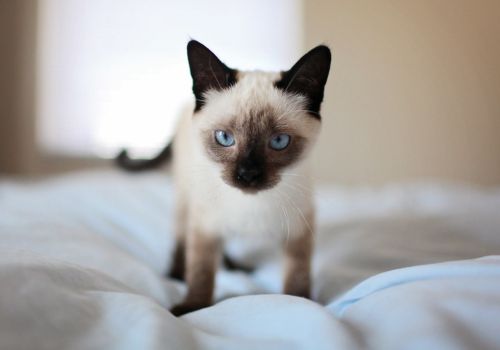
If you've found yourself captivated by the allure of those dazzling blue eyes and that chatty personality—welcome to the wonderful world of Siamese cats! It's hard to resist those unique characteristics that probably nudged you to bring this furball into your life, right? Let's see if we can guess what won you over.
So Much To Love:
- Loves to chat (or, let's be real, meow-monologue about their day)
- A never-ending ball of playful energy
- Your go-to sidekick and cuddle buddy
- A socialite among both kiddos and other fur friends
- Rocking that sleek, low-maintenance coat
- Smarty-pants level: Genius—this kitty can learn tricks!
You might've also found out that:
- They have an opinion—on everything—and they're not afraid to voice it
- Your personal space? They think it's our personal space
- Loves being around humans so much, being alone too long is a no-go
The big question: Is all this personality worth it? Well, if you're reading this, you probably already know the answer is a resounding "YES!"
Here's a quick history lesson:
Siamese cats originated from what was once known as Siam—now Thailand—back in the late 19th century. Their distinctive two-toned coats and soulful blue eyes are just the tip of the iceberg. They're chatterboxes with a unique low-pitched meow that you'll grow to love (or at least, understand). They thrive on human interaction and get along famously with other pets. Plus, they're whip-smart, capable of learning anything from fetch to cabinet espionage.

So, if you're up for the adventure, a Siamese cat promises a life filled with conversation, companionship, and lots of playtime. What's not to love?
Genetic Predispositions for Siamese
The Mysterious World of Feline Amyloidosis
Let's dive into Amyloidosis, a condition where a particular protein known as amyloid accumulates in your kitty's organs—especially the kidneys, liver, and pancreas. Fun (or not-so-fun) fact: this is the same protein that shows up in human Alzheimer's patients! This buildup can lead to organ failure, and while blood or urine tests might give you a heads-up, a tissue biopsy is the gold standard for diagnosis. There's no cure, but medications and dietary changes can offer supportive care for the affected organs.
When Your Cat's Esophagus Goes "Mega"
Next up, let's talk about Megaesophagus. Imagine a conveyor belt that's supposed to move items from Point A to Point B. Now, imagine it's jammed and overstretched—well, that's what happens with your cat's esophagus when it's affected by this condition. The result? Your fur-baby might bring back up their food in an oddly tube-shaped form. Special feeding techniques and diet alterations can be a game-changer. And because diagnosis early is key, do let us know about any strange eating or vomiting behaviors!

The Many Faces of Feline Cancer
Cancer is, unfortunately, a significant cause of illness for older cats, and Siamese cats seem to have an even higher risk. The good news? Many forms are treatable through surgery or chemotherapy. Spotting it early through regular check-ups and blood work is absolutely crucial.
Lymphoma: The Treatable Offender
Now let's focus on a type of cancer that Siamese cats are particularly prone to—Lymphoma. This one impacts white blood cells and can appear almost anywhere in the body. It's also one of the more treatable forms, especially with chemotherapy, though it can be costly and requires a long-term commitment.
Thymoma: The Young Cat's Nemesis
Another cancer Siamese cats are susceptible to is Thymoma, often striking the young ones. The silver lining? Most respond well to treatment, with some even achieving life-long remission.
Beware the Nasty Mast Cell Tumors
Mast cell tumors often pose as innocent lumps, but they're anything but. Early detection through surgical removal and testing is key to combating this aggressive skin cancer.
Adenocarcinoma: The Intestinal Invader
Last but not least, Siamese cats are also at a heightened risk for adenocarcinoma, a nasty intestinal cancer. Its tumors often look like donuts wrapped around the intestines, blocking the passage and leading to severe symptoms like vomiting and diarrhea. The sooner we catch this, the better the chances for effective surgical removal.
Sensing Too Much: Feline Hyperesthesia Syndrome
Feline Hyperesthesia Syndrome! Think of it as the opposite of anesthesia. Your kitty doesn't feel less; they feel more—a lot more. Even a slight brush against the skin can send ripples along your cat's back. And trust us, they're not enjoying this heightened sensory experience. Some even go as far as self-mutilation, trying to lick or chew the sensation away. A thorough diagnostic process is crucial because other skin or nerve conditions might mimic hyperesthesia. The good news? If it's only about chewing, something as simple as flea prevention could be the answer. For the harder cases, medications can help, although a watchful eye is always essential to ensure your fur baby isn’t putting themselves in harm’s way.

Eye Tricks: Convergent Strabismus and Nystagmus
Now, let's talk eyes—specifically, crossed eyes or Convergent Strabismus. While this might be labeled a birth defect in other breeds, it's just another quirky feature in Siamese cats. But that's not all! You might also notice their eyes darting side to side, which is known as Nystagmus. Interestingly, these feline friends aren't seeing double; their brains work extra hard to give them a unified visual experience. Neither of these eye conditions poses a health risk, and many find them irresistibly adorable!
Fading Light: Progressive Retinal Atrophy
Progressive Retinal Atrophy (PRA) is a heartbreaking condition found in some Siamese lineages. Imagine a ticking clock set to gradually dim your cat's world into darkness. There’s no cure, and the first sign is usually night blindness, progressing eventually to total loss of vision. It's crucial for breeders to test for PRA, as even cats with "normal" parents can inherit this recessive gene. Awareness and early detection are vital, especially if you're considering breeding.
Wheezy Whiskers: Feline Asthma
Feline asthma can be a real spoiler, especially for Siamese cats. Think of it as a tiny villain inflaming your cat's small airways, leading to a cough often mistaken for a "hairball cough." The catch? Cats don't really cough with hairballs; they vomit. If your cat’s cough lasts more than a day or keeps coming back, it's vet time! Various treatments, including inhalers and oral medications, can offer relief.
Snuggly Habits: Wool Sucking
Siamese cats sometimes find comfort in the oddest of habits: wool sucking. They'll latch onto blankets, soft fabrics, or even their own tails! This behavior seems to work like a stress ball, and for most cats, it's utterly harmless.
Overly Attached: Separation Anxiety Syndrome
Siamese cats are often known for their love of human companionship, but sometimes this love crosses into the realm of separation on anxiety. Symptoms can range from shredding your favorite magazine to forgetting where the litter box is when you're not around. The trick to keeping an anxious Siamese entertained is a variety of toys and puzzles, along with a consistent routine. If the situation is severe, your vet might recommend anti-anxiety medication.
If you have questions and you'd like to reach out to us, you can call us directly at 615-283-9040, or you can email us at info@crahps.com. Don't forget to follow us on social media Facebook, Instagram.
